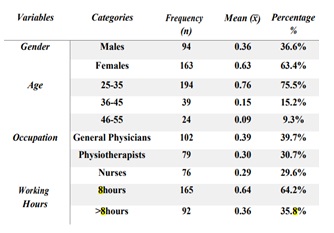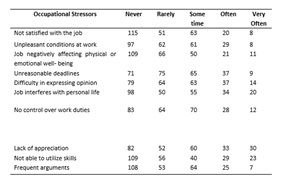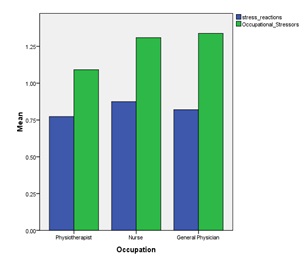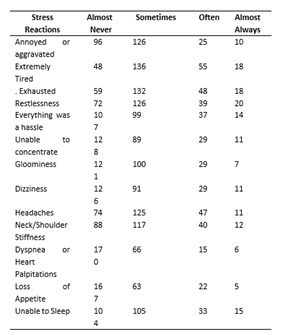ABSTRACT
BACKGROUND AND AIM
The objective of the present study was to identify occupational stress and its reaction to psychological and physical health among different healthcare professionals in Karachi.
METHODOLOGY
An observational cross-sectional study was performed on 257 healthcare workers, including the physiotherapists, general physicians, nurses age between 25-55 years and working for 8 or more hours. A Convenient non- probability purposive sampling technique was used to collect the data. Data was collected from hospitals in 4 districts of Karachi, through the Brief Job Stress Questionnaire (BJSQ) and Job Stress Questionnaire. SPSS (Statistical Package for Social Sciences) Version 16.0 was used. ANOVA & Post HOC analysis was used to compare the effects of variables. (P-value <0.05 considered significant).
RESULTS
Out of 257 participants n= 94 were males and n=163 were females. Among the total sample n=102 were General Physicians, n= 79 were Physiotherapists and n=76 were nurses. Insignificance was found when the occupation was compared with both occupational stressors (p=0.093) and with stress reactions (p=0.456).
CONCLUSION
Overall general physicians experience more occupational stressors than nurses and physiotherapists. Moreover, the study found that female health-care workers are more affected by occupational stress than men.
KEY WORDS
Mental health, anxiety, health personnel, physical health, stress reaction, occupational stress.
Amna Yaseen
Lecturer, Dpt
Baqai Medical University
ORCID ID: 0000-0001-9297-423X
Umema Tariq
Student, Dpt
Baqai Medical University
ORCID ID: 0000-0003-4191-3116
Neha Mohammad Ismail
Student, Dpt
Baqai Medical University
ORCID ID: 0000-0003-1930-2124
Ayesha Sheikh
Student, Dpt
Baqai Medical University
ORCID ID: 0000-0001-6329-1720
[Yaseen A, Tariq U, Ismail NM, et al. A Survey of Occupational Stress Reactions among Healthcare Workers.
Pak.j.rehabil. 2022; 11(1):17-26]
DOI: 10.36283/pjr.zu.11.1/004
INTRODUCTION
Occupational stress (OS) is defined as any emotional and physical responses that occur due to increased job requirements that do not meet the ability, needs and resources of an individual1. Multiple aspects of the work environment involving organization, management, and quality of interpersonal relationships are considered the contributing factors for stress development and persistent stress can cause severe stress reaction by affecting individual’s mental, physical and behavioral state which includes: sleep disturbances, depression, headache etc.2. The physical and mental reaction caused by job stress is considered as occupational stress reaction. Occupational stress negatively affects physiological, psychological and physical status resulting in reduced productivity, low self-esteem and job frustration, 3. Several studies have shown direct relationship between occupational stress and depression 4.
According to a study by the nurses in ASEER region hospitals, only 7.4% of nurses perceive their work as stress-free, whereas 78.8% perceive their work as extraordinarily stressful, and 13.8% consider their work as a significant source of stress5. A study done by Shamona Maharaj reported that there was a 30% prevalence rate of depression among nurses [6]. Similarly, a study conducted by Emmanuel Kokoroko among nurses of Ghana had reported that high workload is related to high job stress and co-workers support can minimize negative effects of job stress 7.
Many factors have been found causing occupational stress and they may be categorized as occupational and individual stressors. Physical factors (includes long working hours, faulty posture etc.), working environment (includes noise, radiation, heat/cold etc.), Interpersonal relationship at workplace, career development, psychosocial factors include, individual characteristics (such as gender, age, personality traits), self-perception, self-confidence, and ability to cope with stress 8.
Zhang Ying in his research analyzed occupational stress and found high levels of occupational stress among healthcare workers, and also found that high levels of occupational stress contributed to lower quality of life among healthcare workers9. The physiotherapist’s job involves recognizing human movement, dysfunction, and re-correcting them. During therapy, physiotherapists use different postures and positions that cause musculoskeletal discomfort and ultimately build anxiety10. A survey of physiotherapists evaluating workplace stress showed that most physiotherapists believe that they have been moderately stressed (48.78%) due to work-place stress11. Similarly, a physician’s job is characterized by long working hours, no or few breaks during work, relationships with other healthcare workers and responsibility for the patient’s well-being [12]. A study on emergency healthcare workers of India, found that about 8% of doctors were highly emotionally exhausted, about 14% of doctors had a high level of depersonalization, and about 34% of doctors had a low level of personal achievement13. Likewise, the nursing profession exposes nurses to a risk of developing stress and depression due to irregular schedules, lack of professional support, and meeting patients’ needs14. Occupational stress is one of the health-related problems among nurses, 77% nurses suffered from occupational stress15.
Persistent job stress can cause deleterious effects on the emotional, behavioral, and physical condition of a person. This includes sleep issues, burnout, depression, compromised family relations, diabetes, hypertension, metabolic syndrome, and compromised overall quality of life2. Job burnout is a mental health impairment occurring due to consistent occupational stress16. Occupational stress prevalent among healthcare workers due to which; their well-being is being impacted. Many studies have shown high levels of stress and its adverse impacts on health professionals working in a different healthcare setting 17.
Most people try to use strategies that help them to overcome stress. These strategies are called coping strategies. Coping involves cognitive, and behavioral approaches to overcome or relieve stressful circumstances18. There are two goals of coping strategies. One is problem-focused, which consists of changing stressful conditions and the second is emotion-focused, which includes handling the response to the stressful environment19. Social support, a positive attitude, and understanding the situation and responsibility is the mainstream of coping strategies (Barbra Roberta Cardoza da Costa and et.al).
The job of physiotherapists, general doctors and nurses in the medical profession are known to be extremely stressful. Therefore, it was essential to understand how work-related stressors affect professionals and workplace factors that cause an intense burden. The objective of this study is to assess the levels of occupational stress and its reactions among different health professionals, including nurses, general practitioners, and physiotherapists in various hospital settings of Karachi.
MATERIALS AND METHODS
An observational cross-sectional study was conducted at different hospitals in districts of Karachi which included Fatima Hospital (malir district), Atia General Hospital (malir district), Mumtaz Medical Complex (malir district), Nehal Hospital (malir district), Dow University Hospital (south district), Jinnah Postgraduate Medical Centre (south district), Civil Hospital (south district), Ziauddin Hospital (south district), Liaquat National Hospital (east district), Aga Khan University Hospital (east district), Patel Hospital (east district), Darul Sehat Hospital (east district), Memon Medical Institute Hospital (east district), Shamsi Hospital (Korangi district) and Shaukat Omar Memorial Hospital (Korangi district) from October to December 2020.
A sample size of 257 healthcare workers was calculated by OpenEpi version 3.0 with a confidence level of 95%, which included physiotherapists, general physicians and nurses who were clinicians or working in hospitals were included in the study. Convenient non- probability purposive sampling was used along with randomization, both male and female healthcare workers with age between 25-55 and working for 8 or more hours daily were included, workers with less than 1year experience and retired professionals were excluded from the study.
Data was collected through questionnaire which consists of four sections, section A having demographic facts which includes name, gender, age, occupation and district, section B having 10 questions related to occupational stressors, taken from Job Stress Questionnaire (JSQ; American Institute of Stress, 2009) reliability α=0.7920, section C consists of 13 questions related to stress reactions, acquired from Brief Job Stress Questionnaire having reliability α=0.65 [21], and section D contains 2 questions concerning satisfactions. Participants rated stressors in terms of 5-point Likert scale and stress reactions in terms of 4-point Likert scale. Ethical approval was granted by the IRB (Institutional Review Board) for the study.
SPSS (Statistical Package for the Social Sciences) Version 16.0 was used, ANOVA and post hoc analysis was used to compare the effects of variables.
RESULTS
Out of the 257 of total participants females’ proportion is higher than males, n=94(36.6%) were males and n=163(63.4%) were females. Most of the participants (75.5%) belong to the age group of 25 to 35 years, 15.2% belong to the age group of 36 to 45 years and only 9.3% belong to the age group of 46 to 55 years. Moreover, n=102(39.7%) candidates were General Physicians, n=79(30.7%) were Physiotherapists and n=76(29.6%) were Nurses. Out of the total, n=165 participants among them work for 8hours and the remaining n=92 work for greater than 8hours. Shown in table 1

Table 1: Distribution of Demographic Details.
OCCUPATIONAL STRESSORS
Occupational stressors are compared with age groups, occupations and job satisfaction levels by using One-way Anova. Results are significant when compared with age groups (p=0.00) and after post hoc analysis the result shows a difference between 25-35 and 46-55 age groups (p=0.00). Statistically insignificant differences are found between occupational stressors and occupation (p=0.093).
The results are significant when compared with job satisfaction level (p=0.000), there was a difference of mean between satisfied and dissatisfied but it was statistically insignificant (p=0.128).
By using independent sample t-test gender, working hours and personal life satisfaction are compared with the occupational stressors. The results are statistically significant when compared with gender (p=0.016). Working hours shows a significant positive correlation with the stressors (p=0.007), the workers who work for hours had a mean value of 1.153 and those who work for greater than 8 hours had a mean value of 1.433 and personal life satisfaction (p=0.00). Different occupational stressors were shown in table 2.

Table 2: Distribution of Occupational Stressors.
STRESS REACTIONS
The 25-35 age group shows statistically significant differences when compared with 36-45 (p=0.006) and 46-55 (p=0.000). The findings of comparison with satisfaction level were significant with a p-value of 0.000. The comparison with occupation shows insignificant results (p=0.456) and among them nurses show greater reaction with a mean value of 0.8745, followed by general physicians having a mean value of 0.8198 and lastly the physiotherapists with a mean value of 0.7731.
Independent sample t-test is applied on gender and working hours. Females show more stress reactions (x̅ =0.900) and male shows less reactions (x̅ =0.685). Stress reactions showed statistically significant findings with working hours (p=0.015). Significance is found in between personal life satisfaction and stress reaction (p=0.000). Those who are somewhat satisfied have higher level of stress reaction with a mean value of 1.230 and satisfied participants had shown low level of stress reactions (x̅ =0.724).
Fig 1: Comparison of occupation with occupational stress reactions and occupational stressors.

Different stress reactions were shown in table 3, the mean values are shown in Figure 1.
COMPARISON OF DEMOGRAPHICS WITH JOB & PERSONAL LIFE SATISFACTION
The demographics are compared with job satisfaction and personal life satisfaction by applying the chi-square test. There was a significant association of gender with satisfaction level with p-value of 0.030. Age group shows significance with job satisfaction (p=0.001) and insignificance with personal life satisfaction (p=0.068). Occupation shows insignificance with job satisfaction (p=0.24) and with personal life satisfaction (p=0.780).

Table 3: Distribution of Stress Reactions.
DISCUSSION
This study was focusing on occupational stress reactions among physiotherapists, nurses and general physicians. The analysis of the outcomes showed that there was a high occurrence of occupational stress among Healthcare Profession, General Physicians showed 35.80% while nurses showed 35.02%and physiotherapist showed 29.19% sensitivity to stressors, which was not similar with the results that had already published, in which 1232 participants including nurses, physicians, therapists, technicians and administrative staff, all suffering from a great burden of stress. Among them nurses showed a high degree of stress 72%, while physicians showed 65% and other staff showed 54-59% 22.
In this study, it is confirmed that there are many factors of occupational stress which includes lack of appreciation (15.2%), difficulty in expressing opinion (13.9%), unreasonable deadlines (13.7%), workload (13.3%), no control over duties (13.1%), cannot utilize skills (12.3%), unsafe working conditions (11.8%), and frequent arguments (11.1%). However, a study on healthcare workers had reported as workload (71.7%) being the main cause of stress, and other factors including arguments at workplace (33.3%), lack of social support (16.3%), changes of shift (10.4%) and others (10.4%)23. Another study had reported that job performance was enhanced by having high job satisfaction24.
Results of previous studies have shown that, among the physical symptoms investigated, fatigability (58.5%) and irritability (59.3%) was the most experienced symptoms at the workplace, while other symptoms were also reported including heart palpitations (40%), weakness (11.9%) & others (11.9%) [25 & 26], with a result very similar to the present study in which one of the most experienced symptoms was extremely tired (23.4%), exhaustion (22%) and restlessness (20.6%). Another study done by Saima Javed, specifically done to assess low back pain among physiotherapists had revealed that almost 69% physiotherapists suffer from low back pain within 2 years of their practice 27.
The analysis of the results reveals that 40.1% General Physicians were satisfied with their job, nurses had shown a satisfaction level of 31.7% and while physiotherapists had shown 28.1% satisfaction. Although the results were not much similar in a study of Lal A done on 345 physicians of USA, the percentage was high of those physicians which were satisfied with their job (98%) and those who were not satisfied (23%)28. Another survey conducted by Rabia Usman among physiotherapists had reported that almost 57.7% were moderately satisfied with their job while 20% had a high level of satisfaction and only 22.2% showed low satisfaction level towards their job29.
This study has possessed some limitations such as,
- Only 3 categories of healthcare workers are included.
- Results cannot be generalized due to the smaller sample size and unequal frequency distribution of occupation.
- Recently, most of the healthcare workers suffered from stress due to COVID-19 pandemic as we didn’t have any Screening Performa to exclude environment related stress, so we didn’t have the access to purely assess occupational stress factors.
Although many studies are present regarding occupational stress among healthcare workers that emphasize on causes of stress, for further scope of this study we will recommend that there should be more research on stress reactions and coping strategies as we found less evidence regarding reactions and coping strategies.
CONCLUSION
According to the findings of this study, general physicians experience more occupational stressors than nurses and physiotherapists and due to occupational stress their physical, physiological, and psychological health is affected and they suffer from extreme tiredness, headaches, inability to concentrate, joint stiffness, sleep disturbances, dizziness, and loss of appetite. Moreover, the study found that female health-care workers are more affected from occupational stress than men and also young health-care workers are more sensitive to occupational stressors and thus show greater stress reactions than any other age groups. Therefore, emphasis should be placed on interventions to help health-care workers to cope with these occupational stressors. The findings of this study may help to develop interventions in future that lessens, decreases, or diminish some of these stressors. With the special occupational health education and training programs, the ability of health-care workers to cope with their job demands and their responses to this demand may be improved.
ACKNOWLEDGEMENT
The authors would like to acknowledge the contribution of our supervisor Dr. Mahwish Shamim, Director of Baqai Institute of Physical Therapy and Rehabilitation Medicine for administrative support. We are also thankful to our co-supervisor Ma’am Amna Yaseen for helping with designing the data collection tool and collection of data. We all are extremely grateful to all those who participate in this research.
DISCLAIMER
We hereby declare that this research is our original work and has not been submitted before to any foundation.
Further, I have recognized all the sources utilized and have referred to this in the reference area.
REFERENCE
- Sagar S, Ravish KS, Ranganath TS, Ahmed MT, Shanmugapriya D. Professional stress levels among healthcare workers of Nelamangala: a cross sectional study. Int J Community Med Public Health. 2017;4(12):4685-91.
- Ribeiro RP, Marziale MH, Martins JT, Galdino MJ, Ribeiro PH. Occupational stress among health workers of a university hospital. Rev Gaúcha Enferm. 2018;39:1-6.
- Faraji A, Karimi M, Azizi SM, Janatolmakan M, Khatony A. Occupational stress and its related demographic factors among Iranian CCU nurses: a cross-sectional study. BMC research notes. 2019;12(1):634.
- Song KW, Choi WS, Jee HJ, Yuh CS, Kim YK, Kim L, Lee HJ, Cho CH. Correlation of occupational stress with depression, anxiety, and sleep in Korean dentists: cross-sectional study. BMC psychiatry. 2017;17(1):398.
- Aserri, M.M.A, & et.al. Prevalence of Occupational Stress and Related Risk Factors among Nurses Working in ASEER Region.Health.2021;13(2):110-122.
- Maharaj S, Lees T, Lal S. Prevalence and risk factors of depression, anxiety, and stress in a cohort of Australian nurses. Int J Environ Res Public Health. 2019;16(1):1-10.
- Kokoroko, E, & Sanda, M.A.Effect of Workload on Job Stress of Ghanaian OPD Nurses: The role of Co-Worker Support.
- Baylina, P, & et.al.Healthcare Workers: Occupational Health Promotion and Patient Safety.J Med Syst.2018;42(159):1-8.
- Li Y, Sun X, Ge H, Liu J, Chen L. The status of occupational stress and its influence the quality of life of copper-nickel miners in Xinjiang, Chianina J Environ Res Public Health. 2019;16(3):1-10.
- Nathiya N, Sasikumar K, Jagannath M, Thangaraj M, Adalarasu K. An observational study on occupational stress among physiotherapists. J Pharm Biomed Anal. 2017;10(2):889-94.J SHAW.2019;10(3):341-346.
- Carmona‑Barrientos, I, Gala‑León, F.J, & et.al. Occupational stress and burnout among physiotherapists: a cross‑sectional survey in Cadiz (Spain). Hum Resour Health.2020;18(91):1-10.
- Hassan, N.M, & et.al.Job stress among resident physicians in Tanta University Hospitals, Egypt.Environ Sci Pollut Res.2020;27:37557–37564.
- Baruah, A, Das, S, & et.al.Degree and factors of burnout among emergency healthcare workers in India.Int J Sci Res.2019;8(4):41-45.
- Maharaj S, Lees T, Lal S. Prevalence and risk factors of depression, anxiety, and stress in a cohort of Australian nurses. Int J Environ Res Public Health. 2019;16(1):61.
- Neto, E.M.N, & et.al. Factors associated with occupational stress among nursing professionals in health services of medium complexity.Rev Bras Enferm.2020;73(1):1-9.
- Mattei A, Fiasca F, Mazzei M, Necozione S, Bianchini V. Stress and burnout in health- care workers after the 2009 L’Aquila earthquake: a cross-sectional observational study. Frontiers in psychiatry. 2017; 8:98.
- Peter, K.A, & et.al.Work-related stress among health professionals in Swiss acute care and rehabilitation hospitals – a cross-sectional study.JCN.2020;29(15-16):1-38.
- Da Costa BR, Pinto IC. Stress, burnout and coping in health professionals: A literature review. J Psychol Brain Stud. 2017;1(1):1-8.
- O’Dowd E, O’Connor P, & et.al. Stress, coping, and psychological resilience among physicians. BMC health services research.2018;18(1):1-11.
- Rubab U. Impact of work family conflict on burnout and workplace deviant behavior: mediating role of stress. Jinnah Business Review. 2017;5(1):1-10.
- Yada H, Abe H, & et.al. Job-related stress in psychiatric assistant nurses. Nursing Open. 2018;5(1):15-20.
- Hämmig O. Work- and stress-related musculoskeletal and sleep disorders among health professionals: a cross-sectional study in a hospital setting in Switzerland.BMC Musculoskeletal Disorder.2020;21:1-11.
- Zarallo G.R, & et.al.Work Stress of Health Professional Workers in Public Hospitals: A Descriptive Study.BAOJ Med Nursing.2018;4(3):1-5.
- Bashir, A, & et.al. Work conditions and job performance: An indirect conditional effect of motivation.Cogent Bus Manag.2020;7(1):1-16.
- Tür F.C, & et.al. Occupational stress experienced by residents and faculty physicians on night shifts. Scand J Trauma Resusc Emerg Med. .2016;24(34):1-8.
- Yoshioka N, Nomura K.Association between Job Stress and Number of Physical Symptoms among Female Nurses of Medical-university-affiliated Hospitals.Jpn J Hyg.2018;73(7):388-94.
- Javed S, Sultan AJ, Khan MU, Rahim M. Frequency of work related to low back pain among physical therapists.Pak. j. rehabil. 2013;2(2):38-44.
- Lal, A, & et.al.The prevalence, determinants and role of empathy and religious or spiritual beliefs about work stress, job satisfaction, coping, burnout and mental health in the medical and surgical faculty of a teaching hospital: a cross-sectional survey.J Int Med.2020;41(4):232-240.
- Usman R, Nafees F, Farooqui SI, Faruq NM. Level of Satisfaction of Physiotherapists with Regards to their Profession.PJR.2013;2(2):27-31.
